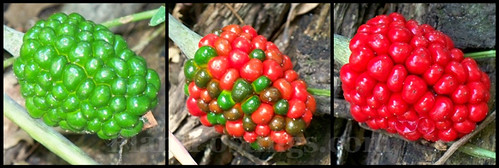
Embarrassingly, I only learned recently that Jack-in-the-Pulpit (Arisaema triphyllum) is an herb (it lacks woody tissue when mature). I also learned that all parts are extremely toxic to most animals, including humans, but that when cooked or dried, its corm (fleshy root) is edible. In fact, historically it apparently was a staple of some Native American cuisines, according to many sources, including the Lady Bird Johnson Wildflower Center.
I'll leave the research on how to dry and cook it to you, since I won't be trying this one any time soon. It sounds too dangerous.
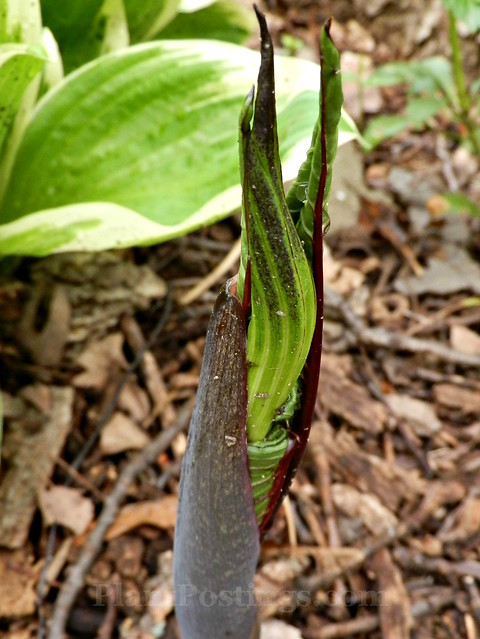
What I do know is that this beautiful, unique North American plant is extremely common in my woodland garden. In fact, volunteers pop up all over the place--probably by seed carried by birds who eat the berries.
The plant is common in most of eastern North America in woodlands, swamps, and marshes--but particularly common in deciduous forests, which explains why it will grow in part sun or in shade. It prefers humus-rich, moist soils. But when we had a summer-long drought in 2012, the plants came back in full force the following year.
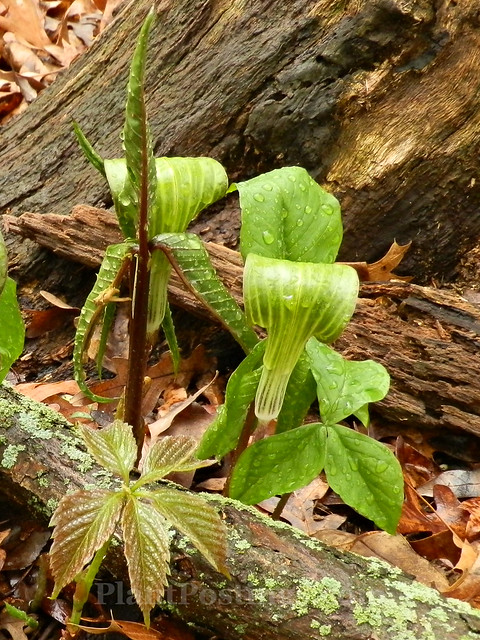
Jack-in-the-Pulpit seems to prefer the same growing conditions as Virginia Creeper (Parthenocissus quinquefolia) and various Trilliums. In fact, Jacks and Trilliums tend to bloom about the same time in my garden, and it can be hard to differentiate Jacks from Great White Trilliums (T. grandiflorum), unless blooms are present.

Often, I'll find colonies of these plants together in mid-spring.
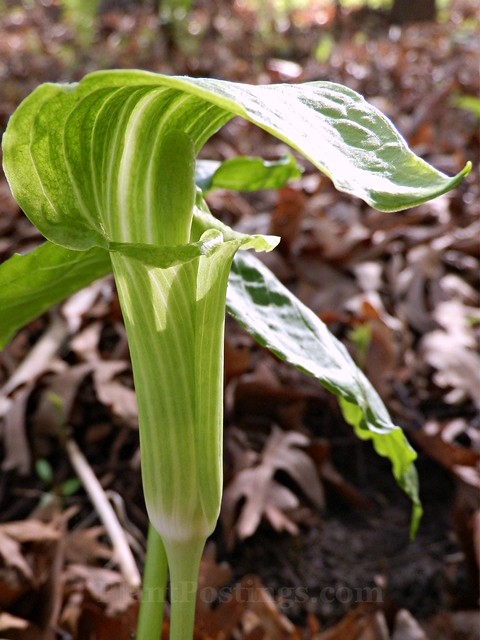
Some Jacks are mostly green, with white stripes.
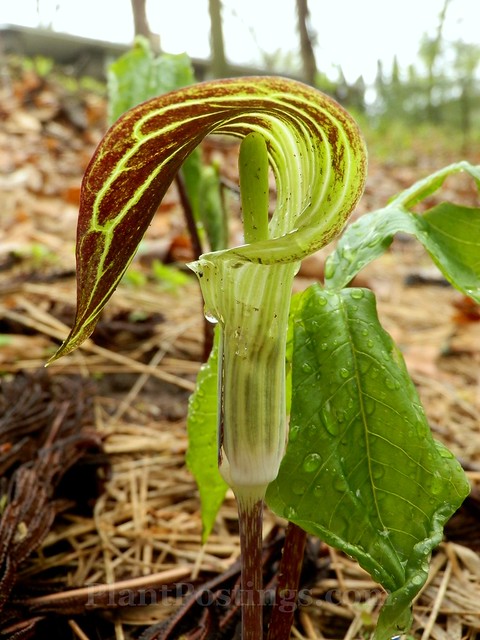
Others have fascinating patterns of brown to burgundy markings.

I enjoy watching the foliage unfurl on stems parallel to the flower stems.
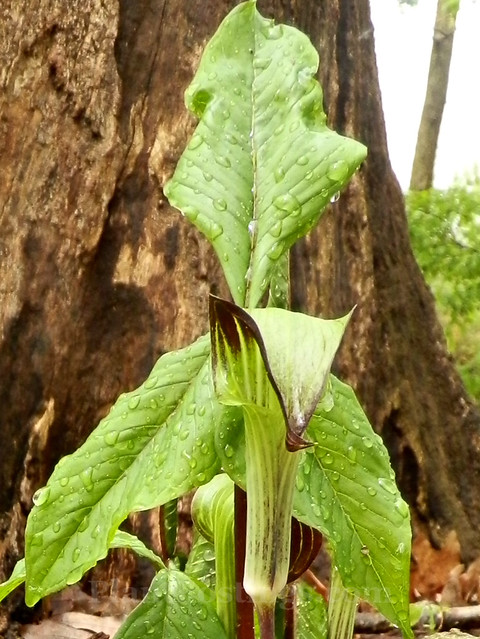
They all seem to have different shapes and sizes.
Each individual plant has a gender. You can tell by looking under the hood! Also, each plant can change its gender from season to season. This excellent resource from Michigan State University explains the gender characteristics in great detail.
Oh, and another nifty thing is that pollinators are more likely to escape from a male flower than a female flower, because the males have an escape hatch!
After the flowers fade, the pollinated plants produce clusters of berries.

They begin bright green,
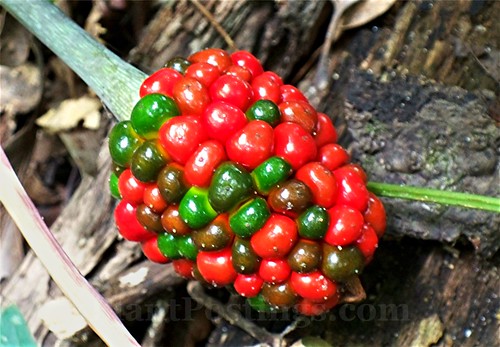
Change to multicolored,

And end a bright red that brightens the late summer and autumn landscape, if the birds don't get them first.
Jack-in-the-Pulpit grows 1 ft. to 3 ft. in height, and blooms from March to June, depending on your zone and the specific growing season. It's hardy in USDA zones 4 to 9. It seems readily available from most garden centers in my area and from online North American native plant sellers.
I consider this plant a familiar old friend, as it grows wild and is wonderfully plentiful in my woodland garden.
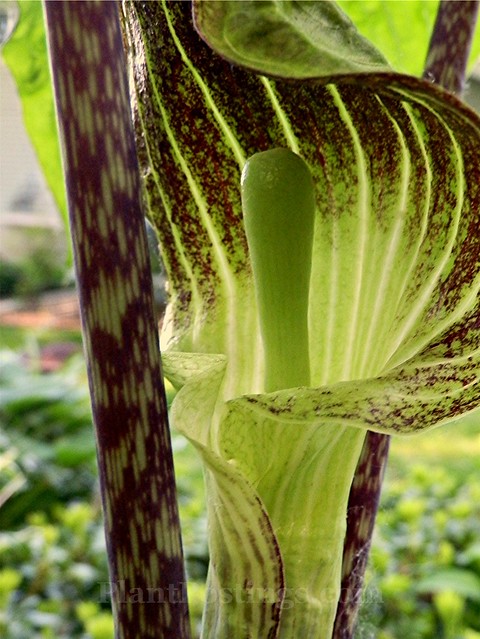
I'm linking this post to Dozens for Diana over at Elephant's Eye on False Bay, a meme that celebrates a "plant a month" on blogs from around the world.
Jack is a plant I've never tried to grow in my garden--such interesting info, Beth! I had no idea there were different genders in plants, other than trees and some shrubs. Did you have a frost this week? We escaped it Friday night, but not Saturday night. I thought it hadn't affected things too much, until I looked closer late Sunday--most of my annuals, including the Zowies are pretty much toast.
ReplyDeleteHi Rose: I admit I learned many more things about Jacks after researching for this post. They're a favorite plant in my garden, but I didn't realize how to differentiate the genders, so I will look more closely next spring. There's so much more about this plant (or any plant, of course) than can be covered in a small, informational post. Regarding the frost: No, we didn't get it, believe it or not! I think some people around us did, but I guess several factors kept the temps just above freezing throughout most of my garden--trees, lakes, being somewhat elevated from the valley, etc. The Hostas seem to have had a touch of frost, but they're still mostly green. All my annuals survived, and only a few of them were covered. Crazy!
DeleteAre you joining my Dozen for Diana?
ReplyDeleteWould you do me a favour and add a link please?
http://eefalsebay.blogspot.co.za/2015/10/melianthus-major-honey-flower-for-birds.html
I wonder if your Jacks are related to our arum lilies, the same sort of seeds and flowers. But yours have more interesting stripes.
Hey Diana: Yes, of course! I'm so glad you're doing the meme again (or maybe I wasn't aware it was continuing all along?)! Link added. Thanks for the notification! Regarding the relationship between Zantedeschia and Arisaema: They are in the same family--Araceae. I wouldn't have known this unless I looked it up, so thanks for asking! We are familiar with Calla Lilies here in the states, as they are prized as cut flowers.
DeleteI do appreciate you joining me with your plant!
DeleteDear Beth, Jack-in-the-Pulpit in such a beautiful and interesting plant! You got some really nice photos of it. I love the natural variations in the leaves. Thanks for providing all this interesting botanical information about it. It is always astonishing what nature is able to come up with!
ReplyDeleteWarm regards,
Christina
Hi Christina: Yes, the miracles of nature are so inspirational. Thanks. Jacks are among the first blooming native plants of the season, and so wonderful to see!
DeleteThank you for this very interesting post on Jack-in-the-Pulpit. We have a plant which is rather similar to your Arisaema, the Arum italicum and this one is very poisenous too and growing like a weed. They have the same cluster of berries only the flower is white. I must say that your Arisaema is much more beautiful.
ReplyDeleteregards, Janneke
You're welcome! Looks like they're in the same family--Araceae. I think I've seen Arum italicum used as house and office plants here. The foliage and the berries are lovely.
DeleteIt's an interesting plant has beautiful leaves, interesting flowers and beautiful fruits, such as corals. Regards.
ReplyDeleteHi Giga: Yes, it is a beautiful woodland plant. I found some of the berries in the garden the other day, but I'm sure the birds have eaten them by now.
DeleteWhat a fascinating post. And plant! I've been meaning to try it for awhile. Really must next year. If it's poisonous does it keep the nibblers at bay?
ReplyDeleteThanks. Yes, it is a fascinating plant, and it seemingly pops up overnight in May. The rabbits don't seem to eat this one--apparently it's toxic to them. Although the birds do eat the berries.
DeleteI've always loved Jack in the Pulpit - the deep colours and the form are so unusual and graceful. I didn't realize they formed berries - those are such a lovely bright red. I'm with you on the whole eating bit - when I read that something is toxic "unless....", I would rather not take the chance.
ReplyDeleteYes, it just doesn't seem worth taking the chance unless you really know what you're doing in cooking or drying them. Some years I find more berries than others. I'm not sure why. I did find a bunch of them a couple of weeks ago, but I'm not finding any in the garden now. Must have fed some of the migrating birds. :)
DeleteI am envious of you! I have colonies of trillium and also virginia creeper, but no Jack-in-the Pulpit! I would love this plant; I must find a good source. Yours are so lovely. Thanks for an informative and very interesting post!
ReplyDeleteDeb: It sounds like we have similar conditions and woodland gardens (except for the climate). I would send you seeds, except I think the birds ate them all this year. I'll check. Also, I've read that the seeds must be kept moist before you plant them, but I could wrap them in plastic in a wet medium. Two good mail order sources: http://prairienursery.com and http://prairiemoon.com. Good luck!
DeleteThis one is new for me. Thanks for sharing!
ReplyDeleteYeah, some plants are toxic when they are eaten raw, but the toxicity usually significantly reduced or disappear when they are cooked or dried
Yes, good point! I just don't want to be the one to recommend consuming this one. It's too prevalent in my area, and from what I'm reading it can be a real problem if people don't prepare it correctly. But for the "experts" it's probably fine. :)
DeleteHi Beth, it is a wonderful plant, I bet it looks great massed under the trees. We have our own Jack-in-the-Pulpit, Arum maculatum, no idea how closely they are related, but they look very much the same! They used to grow in the ancient oak woodlands near where we used to live, I've not seen them around here as yet. Apparently, the starch from the roots used to be used to starch clothing!
ReplyDeleteApparently, the Arums are in the same family (Araceae) as the Arisaemas. Most of them do seem to have similar growth habits, flowers, and seeds. This property is mostly Oak woodland and opening, so that makes sense. How interesting that the roots were used for starch!
DeleteSo interesting, I think it is in the family of it was growing around my home in Majorca. I remember you help me with identification. Thanks!
ReplyDeleteAh, yes. I remember that you shared photos of a similar plant. I can't remember if it was a different species of Arisaema or an Arum? In any case, they're all awesome plants. :)
DeleteWhat an interesting plant. Your photos are beautiful! I imagine that it's a gorgeous member of your woodland garden.
ReplyDeleteThanks, Tina. Yes, I'm always happy to see this plant return in the springtime, along with the Trilliums and other ephemerals. The nice thing about the Jacks is that, unlike the ephemerals, Jacks stay with us throughout the growing season.
DeleteThe Jack that I have is pure green. It is the one you would find in the woods locally. I forget which one it is. It is pretty. I always look forward to it. I know that some critter always gets the seedheads. I don't know what it is but they get them.
ReplyDeleteYes, the seeds seem to disappear here, too. I think the birds eat them when they're just ripe enough. I was surprised to find the same cluster of berries (shown in the first mosaic) in the same spot throughout the growing season a few years ago. Usually, most of the berries disappear.
DeleteThey seed enough in my garden that I pull a lot of them out. So far I've managed to control them without losing them.
ReplyDeleteI've never pulled them out. They grow here and there around the garden (except in the sun, which is scant here). I did clip one seed head this summer to place it in a different spot, but I've never moved the plants. They always seem to find spots that are fine with me.
DeleteI always called this plant 'cuckoo pint' and as children we would grind the berries and put them down each others clothes as itching powder. Survived to tell the tale and as adult have learnt the meaning of pint!!- lords and ladies another name we called it and very interesting to know that they are differently sexed flowers. Will take a closer look this Spring - yours seem prettier though and remind me of pitcher plants
ReplyDeleteInteresting. Kids can be mean! (Oh, the stories we all could tell, right?!) I will have to research the UK Jacks. I always find it interesting when we have similar but slightly different plants on our continents.
DeleteI had no idea it was an herb either. That is so great that you have so many of them in your woodland garden! They seem so rare anymore.
ReplyDeleteYes, they do seem to like it here. Part of this lot (a unique "pie shaped" woodland) was never developed, so it's interesting to find native plants growing wild here. Every season brings new surprises. Linda of "Each Little World" lives nearby and says they're plentiful in her garden, too.
DeleteI love plants like this, not so much beautiful but strange and interesting. I actually noticed some recently in a garden locally. I had no idea what they were, but they looked fabulous. How ifascinating that they can change gender each season. With poisonous plants like this, I always wonder what brave person first discovered they're OK to eat cooked and dried. Sadly I won't be growing it, not if it needs moist soils.
ReplyDeleteYes, I agree, Sue. The gender thing was new to me, as well. And now I know how to identify the genders each season. From what I've read, the reactions can range from itching to burning to greater damage over time, so yes, how did they discover the corm was edible when dried and/or cooked in precisely the right way? And yes, it is better suited to a moist woodland.
DeleteI love arisaemas! I grow the smaller Arisaema amurense, it looks similar, and has orange berries. I dug up around 10 mature plants an possibly 50 tiny corms from my old garden before I moved, hopefully they have survived the summer in pots and will come up next spring. Over here you have to plant them if you want them in your garden, you are lucky finding them growing wild :-)
ReplyDeleteI will look it up! I'm thinking it's not all that common to have them growing wild here, either. This property is kind of unique in that part of it (the woodland) was never developed. So, nature rules in that part of the garden. We do remove invasive plants and maintain a path through it, but the plants do what they will. I kind of remember you posting about your Arisaemas. I will watch for more posts about them next spring! :)
DeleteWonderful photos! I have a few jack-in-the-pulpits here but they haven't increased their numbers much. The weather has been so outstanding lately, I'm going to hate to see it end.
ReplyDeleteThanks, Karen. Ours seem to have good years and slower years. The past couple of years have been good for them. I agree--the weather lately has been incredible. I'm starting to feel uncomfortably cold, especially at night. Time for the long underwear. ;-)
DeleteI'd love to grow these but don't have the magic combo of moist shade. I have a friend with a garden full of them and they are just incredible. My neighbors used to have them in their garden but they've since disappeared. :(
ReplyDeleteYes, they do prefer moist shade. They disappeared during our drought in 2012, but came back in full force the next year.
DeleteI didn't realize they were herbs?! Learning all the time. I used to see these all the time growing up in Virginia & Maryland but not so much out here. I don't think we have the right climate?
ReplyDeleteGlad you haven't had a freeze yet ~ we haven't either & I'm so happy about it!
I know--that was surprising to me, too. Ah, yes, I imagine they would be plentiful in VA and MD. I suppose it might be too dry in Colorado. Regarding the frost: Still annuals blooming, but most of my perennials are going dormant now. Time to start planning the garden for next year!
DeleteWow, I learned a lot from your post. Thank you.
ReplyDeleteMy mom has many jack-in-the-pulpits. I am going to look at them closer now.
Great post.
Carla
They're cool plants, aren't they? Your mom is lucky to have them in her garden, too. I always look forward to seeing them again each spring!
DeleteGreat post! Unfortunately, I have not been successful with Jack - it kept coming down with rust. After seeing your post, though, I'm considering giving them another try.
ReplyDeleteOh, sorry to hear that. I don't remember seeing any rust on the Jacks here. That would be so disappointing. I guess I'll have to watch for it--is it the same rust that affects Crabapples? We do seem to have trouble with that one. The Crabs drop their leaves so early in the fall.
DeleteNot sure how it looks on crabapples ... but it looks like the rust on hollyhocks, lots of little red dots.
DeleteOne of my all time favorites as well and you have the best conditions for it too. Love the shots of the colonies blooming...and the real treat in the fall are those amazing seeds.
ReplyDeleteThanks, Donna. The Jacks do seem to like it here. It's always so magical to see them pop out of the ground each spring. Love the seeds, too.
DeleteA very favorite plant of my husband and whenever we are back east it's fun to search them out during hikes in the woods. Even though they are grown in Zone 9 I'm pretty sure that doesn't apply to our semi-arid climate!
ReplyDeleteHi Shirley: Yes, they are fun to find in the woods. And I imagine you're right: The combination of heat and dry conditions probably isn't the best for Jacks.
DeleteThat's what those seeds were! I saw some of these along the wooded section of the Cap City trail near me, but had no idea what they were. I never saw the flowers when I walked that way last spring, just the seed clusters this fall.
ReplyDeleteAh, that's nifty! I suppose they were at the bright red stage? Soon the birds will eat them up! :)
DeleteI'd never heard of Arisaema until I read a magazine article on them last year, but that didn't capture the beauty of the plant as you have. Those berries look magnificent - I imagine that in the past quite a few people found out the hard way that they were toxic. (I imagine I'd have been on that list as they look good!).
ReplyDeleteHi Tim: Thank you for your kind comments. The Jacks (and the Trilliums and their friends) own this land. Sometimes I wonder how long they've been here. It's so sad to think of development ever taking them away. Yes, that's probably true about the casualties of trying the berries (and other parts of the plant) early in human occupation.
DeleteI've tried several different varieties, finding them perhaps the most intriguing plant of all. Success rate has not been great, but I'll keep trying.
ReplyDeleteThey are pretty special plants--I agree! I suppose this Arisaema is native in your part of the country, too? One of the things I read that I didn't know before is that apparently they like a thick leaf cover through the winter months. Since I dump all my Oak leaves in the woods--no wonder that Jacks are so plentiful back there!
Delete